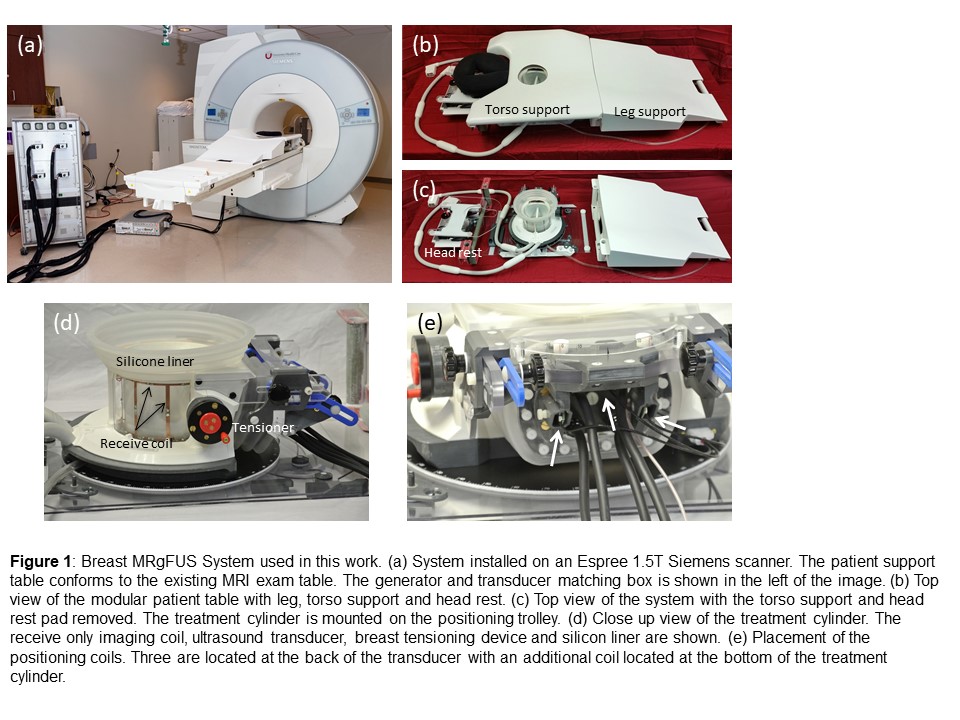
Clinical Trials
The treatment of early stage, localized breast cancer has evolved over several decades from highly invasive techniques to minimally invasive, breast-conserving therapies. MRI can be used in all aspects of breast disease management and is recommended by the American Cancer Society for screening high-risk patients because it offers the most sensitive detection of breast cancer. While therapeutic ultrasound has been studied for decades, recent progress in MRI and ultrasound technologies has renewed enthusiasm in its use for the treatment of several diseases, including breast cancer. Unlike other minimally invasive thermal therapies, focused ultrasound is completely non-invasive and non-ionizing, resulting in shorter recovery times, decreased infection risk and reduced anesthesia requirements. MRI guidance of focused ultrasound (MRgFUS) allows for accurate delineation of the target, real-time treatment feedback with thermometry maps or other MR images, and post-treatment assessment.
Currently, MRgFUS is used to treat many benign and malignant tumors. It is FDA approved for treating essential tremor, bone metastases, prostate disease and uterine fibroids, but not yet breast cancer. MRgFUS is an ideal technology for treating breast disease with the potential for tumor destruction and excellent cosmetic results.
We have pioneered a novel system to noninvasively ablate breast tumor tissue with MR-guided focused ultrasound. Our Muse™ system incorporates a custom breast MR coil that provides high signal-to-noise MRI images within the ultrasound field and an ultrasound transducer that moved and a beam that can be remotely steered to reach nearly any ablation zone in the breast along with a customized, comfort table for patients to lie face-down for the duration of the procedure. These engineering advancements are complemented by complete MRI and FUS protocols that have been optimized for patient safety and the efficacy of the ablation treatment - giving the operator real-time feedback on tissue temperature change and other important quantitative measures like tissue elasticity.
We are working on translating this device to the clinic and we are supporting a clinical trial that is using the Muse System to treat localized breast cancer at the Institut Bergonie in Bordeaux, France. We are also developing advanced treatment planning, monitoring and assessment techniques that allow this technology to be rapidly translated for clinical use.

Related Publications
Farrer, A. I., Almquist, S., Dillon, C. R., Neumayer, L. A., Parker, D. L., Christensen, D. A., & Payne, A. (2016). Phase aberration simulation study of MRgFUS breast treatments . Medical physics, 43(3), 1374. doi:10.1118/1.4941013
Dillon, C. R., Farrer, A., McLean, H., Almquist, S., Christensen, D., & Payne, A. (2018). Experimental assessment of phase aberration correction for breast MRgFUS therapy . Int J Hyperthermia, 34(6), 731-743. doi:10.1080/02656736.2017.1422029
Minalga, E., Payne, A., Merrill, R., Todd, N., Vijayakumar, S., Kholmovski, E., . . . Hadley, J. R. (2013). An 11-channel radio frequency phased array coil for magnetic resonance guided high-intensity focused ultrasound of the breast. Magn Reson Med, 69(1), 295-302. doi:10.1002/mrm.24247
Payne, A., Merrill, R., Minalga, E., Vyas, U., de Bever, J., Todd, N., . . . Parker, D. (2012). Design and characterization of a laterally mounted phased-array transducer breast-specific MRgHIFU device with integrated 11-channel receiver array. Medical physics, 39(3), 1552-1560. doi:10.1118/1.3685576
Payne, A., Todd, N., Minalga, E., Wang, Y., Diakite, M., Hadley, R., . . . Parker, D. L. (2013). In vivo evaluation of a breast-specific magnetic resonance guided focused ultrasound system in a goat udder model . Medical physics, 40(7), 073302. doi:10.1118/1.4811103
Members of the Focused Ultrasound Laboratory have intellectual property in this area of research. Any conflict of interest concerns can be addressed by the investigators or the department chair.